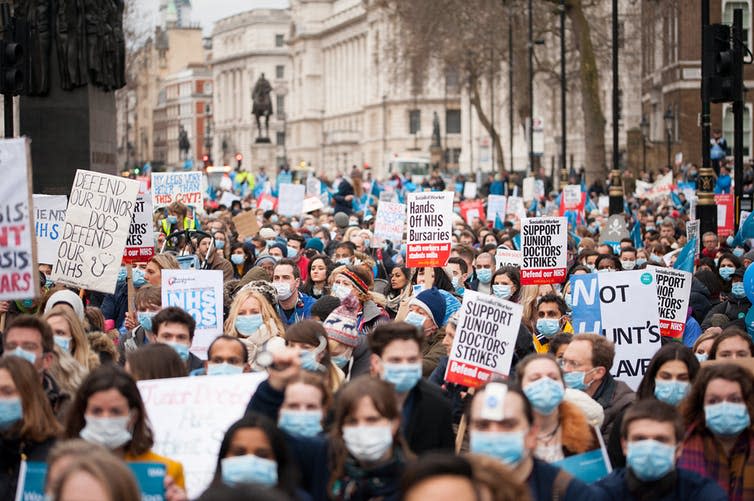Why workers go on strike
The employment relationship – between employer and employee – is full of tensions, bargains and compromises. Even the most motivated employee has days when they would rather be doing something else. Or when they simply dislike the way their boss asked them to do something. These tension points often go unnoticed and unremarked upon. They are usually part of the give and take in the workplace.
Sometimes, however, they flare into something bigger. An industrial dispute is the most collective and formal manifestation of those tensions. A strike brings those compromises into sharp relief for all the parties involved. Strikes have become far less common as there are fewer workplaces where trade unions are recognised and well organised. But they do still happen, as recent strikes among junior doctors and higher education professionals highlight.
Both of these demonstrate how a strike around a fairly technical employment issue can develop a momentum of its own and become a catalyst for a much wider expression of dissatisfaction about the changing bargains being made. As with the concerns raised by junior doctors about the management of the NHS, the higher education pension dispute has rapidly become a space in which to question the broader direction of the sector.
In this context, emotions can run high. Many relationships are strengthened, but some inevitably become strained. By definition, strikes are not business as usual. What then becomes important, is how the parties can explicitly negotiate compromises that smooth the way back to work – even if that means negotiating a new normal.
Strike etiquette
Throughout any industrial dispute, it is important for all parties to keep an eye on the fact that negotiation and compromise are central to employment relationships. Building and rebuilding trust between employer and employee is essential and people rarely forget what has been done and said during a strike. Harsh punitive actions from an employer can damage reputations and risk future business.
Similarly, although strikes are often a platform for discussing broader issues, any agreement to end a strike will ultimately rest on settling the trade dispute that launched the strike action. So managing the expectations of striking workers about what a deal is likely to address, is challenging for union representatives. Compromise is hard for everyone and can throw up some odd trade-offs that are sometimes necessary to get the deal done.

In short, in a negotiation, no one gets everything they wanted. Collective negotiation and compromise is even harder because the negotiators are constantly trying to judge what would be acceptable to their constituents. This makes it very difficult to anticipate the outcome of a deal to end a strike before it is actually concluded.
Finding a new normal
Striking workers often feel they haven’t got a deal that addresses all of their concerns – and that becomes even more challenging when the strike becomes a catalyst for wider issues. Those taking strike action have inevitably lost money and have had to confront their own feelings about breaking the normal patterns of working life. That takes a lot of energy and courage, and often involves questioning norms that are taken for granted about workplace bargains and compromises.
It is unsurprising that any deal often cannot compensate for all of that. On the employers’ side, both the junior doctors and higher education strikes involved multiple employers with different views about where compromises could and should be made. As well as differing views on how to rebuild trust with staff once the action was over. Eventually, even in the most difficult dispute, work does restart sooner or later. But how parties behave during the dispute is remembered long after the deal is done and work begins again.
Importantly, it shapes future bargains and compromises; what the parties are willing to give and take to reestablish working patterns. In occupations such as medicine and higher education, where a lot of work is done on the basis of good will, there are real challenges to rebuilding those relationships.
Read more: University strikes: can workers fully withdraw labour in the digital age?
It is clear that one of the things we are seeing in the higher education dispute is a collective and very vocal expression of dissatisfaction about the expectations of goodwill from staff. It is increasingly clear that it will require an effort on both sides to establish new bargains and compromises, and that some of that good will is diminished. What the new normal will eventually look like is still very much open.
This article was originally published on The Conversation. Read the original article.

Melanie Simms has received funding from the European Commission, Hans Boeckler Stiftung, UnionLearn, and the Nuffield Foundation around the broad topics of union organising, collective bargaining and worker representation.

 Yahoo News
Yahoo News 
